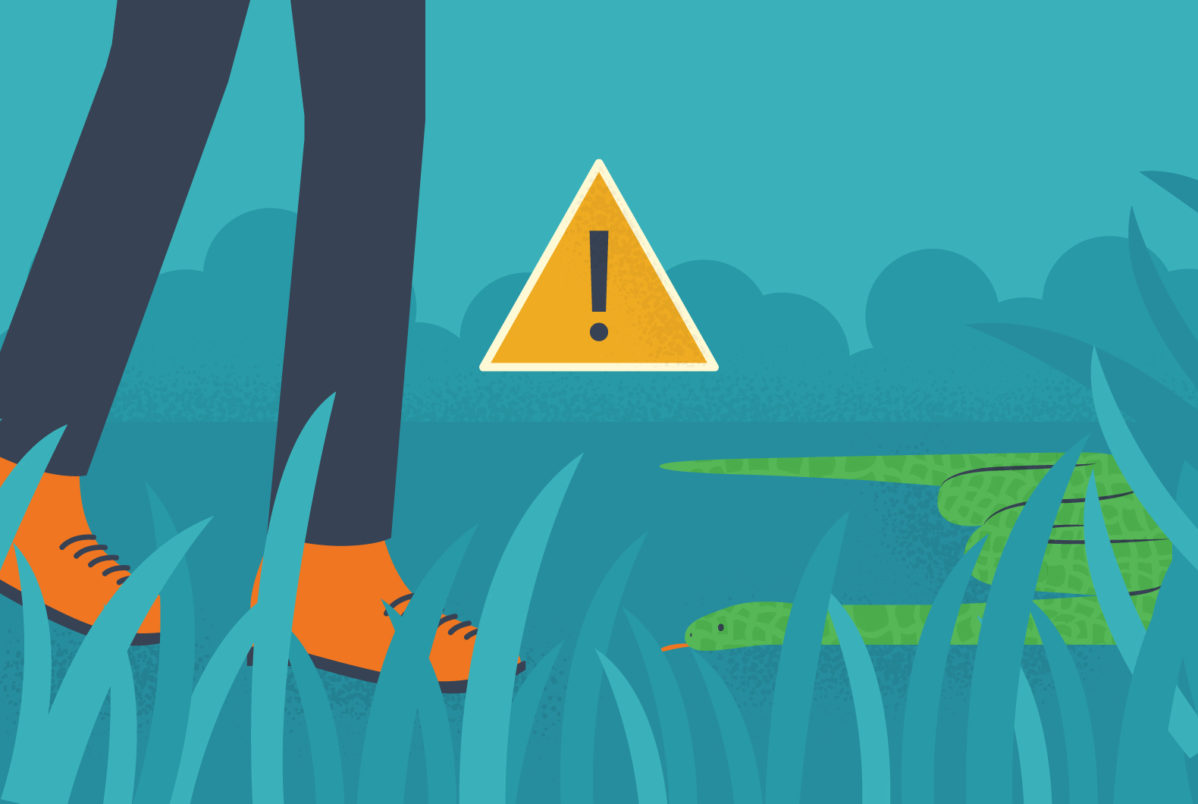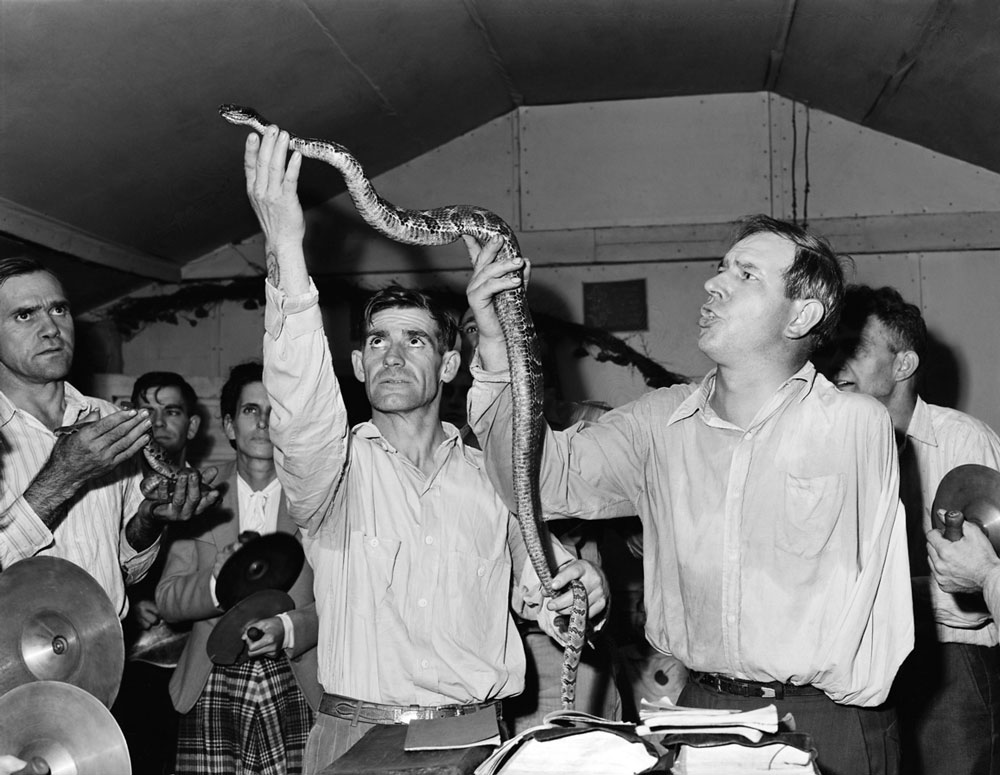

This article was written by Connor, one of our founding editors. Connor is a full-time travel and lifestyle photographer with extensive experience in the outdoors industry.
Although very few snake bites in America end up in death, they can have some nasty side effects.
Firstly, you’ll begin to feel serious pain. If you’re not wearing the best snake boots, you could even suffer from temporary paralysis.
If you’re an avid trekker hunter and frequently venture out into snake country, there’s no question you’re looking for snake proof hiking boots. Well, luckily for you, we’ve reviewed 4 of the best and most snake bite-resistant ones.
Let’s face it; nobody wants to be bitten by a venomous snake, which is why you should opt for the best snake proof boots.

These snake boots have been built extremely well for both withstanding a snake bite and also for rough outdoor use. The rubber material used at the base of the boot means that you are very well protected from any bites.
LaCrosse is well known for producing high-quality protective clothing. Their best snake proof boots are no different, with their strong production values apparent even in the smallest details of this product.
These snake boots have been built extremely well for both withstanding a snake bite and also for rough outdoor use. The rubber material used at the base of the boot means that you are very well protected from any bites.
The main criticism with this boot is that it is pretty bulky. For extended use and on warm days, this can be a bit of a drag. For us though, it’s most definitely not a deal-breaker due to the quality of every other aspect of the boot.
Listen, when it comes to snake boots, Rocky knows what its doing. The company has been around since 1932. This specific model has been in production since 2011, and continues to be one of the company’s most popular snake boots.
It offers reliable protection from North American snakes, including rattlesnakes, coral snakes, and copperheads. What we like about these boots is that they will last you for years to come. Keep them in the closet during the offseason without issue; they’ll be ready to go next year.
Being both highly durable and offering fantastic snake protection makes this pair of boots and ideal choice. Furthermore, if you’re in need of a solid pair of hunting boots, the camouflage pattern is an excellent addition.
They’re also great if you’re wearing them for a long time because they are lighter and don’t get too warm. Of course, this means they’re not exactly ideal in colder temperatures. However, considering when most snakes tend to be an issue (i.e. the warmer climes), this shouldn’t be a cause for concern.
While it’s hard to knock this pair one drawback is that you have to treat them first in order to waterproof them. But that’s the case with a lot of these boots out on the market, so don’t let it prevent purchase.
It’s easy to see that this is a beautiful pair of snake boots, with excellent brown leather design. Of course, design alone doesn’t protect you from a snake bite. As well as looking good, they are effective in protecting from bites.
In fact, in order to prove that they’re not just pretty pair, take a look at this test which was performed on live rattlesnakes.
They’re expensive. You can get serviceable snake boots for a lot less, but then again, they won’t offer the same quality. These look great and offer more style than your average boot. Plus, they’re waterproof.
If you don’t care about aesthetics and you won’t be going anywhere wet, we recommend opting for one of the cheaper models reviewed in this guide.

There are around 8000 venomous snake bites every single year in North America. Simply put, people want to know they are protected when they’re out walking in snake territory.
Snake bite protection and prevention is the best way to deal with venomous snakes. It is much better to prevent a bite than have to deal with being bitten.
Not many bites end up in death at all, but they can leave nasty wounds and scars and a lot of pain. Snake bite proof boots give you the peace of mind to know that you’ll be much safer.
Of course, wearing boots still doesn’t help you if you get bitten on the hand or arm. That’s why you should read this guide we produced on how to prevent a snake bite.
One of the main reasons there aren’t more deaths each year from venomous snakes bites is due to modern antivenom treatment and improvements in protective snake clothing. The symptoms of being bitten by a venomous snake can be different depending upon the snake that bites you.
However, here are some common side effects you can expect to experience:
If you are bitten by a rattlesnake, you can expect to feel the above, plus some other more specific side effects, including:
Here are some of the side effects of being bitten by either a cottonmouth or copperhead snake:
Often, if you’re bitten by a coral snake, the fangs are so small that they may not penetrate the skin fully. However, it is still advisable to seek medical assistance. You shouldn’t assume you’re in the clear until you’ve been fully checked out.
Further, some symptoms of a coral snake bite may not be apparent for hours afterward. Here are some common side effects:
Your very first action after being bitten by a venomous snake should be to protect yourself from being bitten again. Very often, snakes simply give off a warning bite and this is where many people make the mistake of trying to catch the snake or kill it. At this point, you put yourself at risk of being bitten again and suffering worse consequences.
After making yourself safe, call the emergency services straight away and try to describe the snake and where you were bitten. This is what you should do:

The primary aim of wearing snake boots is to protect you from a bite while out hunting or trekking (duh!). Therefore, this should be the first (and most important) factor to consider when buying a pair.
We always recommend researching the brand and reading online reviews. These will help you make an informed decision. Aside from preventing snake bites, you should also look for a pair that suits what you’ll be using them for. Are you going out hunting? Do you need them to be super waterproof or is water-resistant enough?
Maybe you only go out hunting a couple of times per year and they don’t need to be highly durable. Alternatively, you might need a pair that will last forever.
Finally, something many people forget to think of is; how easy are they to take on and off? It might not seem much of a big deal, but when you’re tired after a long walk, you’ll want this to be easy.
Unfortunately, there isn’t a one-size-fits-all method. This is why you need to properly assess your conditions and the likely scenarios you’ll face. If you know that you’ll be up against highly venomous snakes, then it is worth spending the extra money to help prevent a serious bite from occurring.
Of course, there are many kinds of hunting boots reviews available on the market. It’s important to note, although hunting boots can be made from highly durable, tough material, many hunting specific boots haven’t been made to protect against snakes.
The hunting boots we have reviewed above are specifically snake proof hunting boots. The information below is relevant to hunting boots only.
Sifting through the information online can get confusing. Choosing a pair of hunting boots that are not quite right for you can lead to an uncomfortable experience.
If they don’t insulate you enough, your feet will soon get cold and then your whole body will begin to shiver as a result. On the contrary, if they’re too well insulated, you’ll get warm, moist feet which can ultimately lead to blisters.
So, how do you know you’re choosing the right hunting boot? Let’s explore.
The kind of hunting you do plays a big part in the type of boot you should go for. For example, if you’re going to do a lot of walking, then you’ll need a pair which will last the test of time.
This pair should remain comfortable for extended periods of time and not be prone to blistering your feet.
If you’ll likely not be in snake territory, then you’ll need to worry less about how snake-proof they are, and more on the kinds of terrain you’ll be facing. For example, if you’re hunting sheep, deer, and elk, then you’ll probably want a pair that can handle the high-altitude terrain, which can be tough and steep.
If yours if a fairly relaxed hunt, then maybe over boots will do the job. These are also great for extra warmth in icy conditions.
If you mainly go out hunting during the summer months, it is important to opt for breathable hunting boots. They should be lightweight and under around 200 grams of insulation. Although, keep in mind that it can rain, even in the summer.
For cold-weather hunting, boots with 1000+ gram insulation should do the trick. This will allow your feet to retain heat and improve your overall hunting experience.
For mid-season (fall), the weather can be fairly unpredictable. This means you should go for a pair which will cover most scenarios, but not lean too heavily one way or the other. Between 400 and 800 grams of insulation should do, and a waterproof membrane is advised.
As much as it is important for the material to be effective, you should also look for good coverage. That’s to say, you’ll want a pair which will protect the most part of your lower leg and feet as this is where you’re most likely to suffer a bite.
When you’re walking in snake territory, your chances of being bitten are greater when stepping over logs and rocks where snakes like to hide. For that reason, the ideal length of the boot will be between 16 and 18 inches.
Of course, if you want more protection than that, then you should consider looking at snake chaps, which can cover your entire leg. For those of you who go hunting in long grass, for example, chaps may be a suitable addition to your kit.
Different manufacturers can use different materials in order to make the boots as snake proof as possible. Some of these materials include leather, kevlar (also used on motorcycle equipment), denim, synthetic weaves and Cordura nylon.
As well as being effective in being snake-proof, you’ll want your boots to be comfortable. There’s no point going for a super sturdy pair and not actually being able to wear them because they’re too sore on you. What makes a pair of snake boots comfortable?
They should fit snuggly, yet not be restrictive in terms of movement. You’ll potentially have to wear them for hours at a time and nothing will cut your hike or hunt shore quicker than an uncomfortable pair of boots.
Another factor to consider in the comfort section is the ease of closing them up. Are they zipped? Or is it an awkward lace set up which makes it impossible to get in and out of them quickly? Zippers are quick and easy but can catch on bushes and break.
Laces, on the other hand, are a bit of a pain to do up but can be much more sturdy and allow you to tighten them to what you find comfortable. The other option is a slip-on boot which offers ease and means they won’t get caught on anything, but if the fit isn’t quite right then they can be uncomfortable without any way of adjusting.